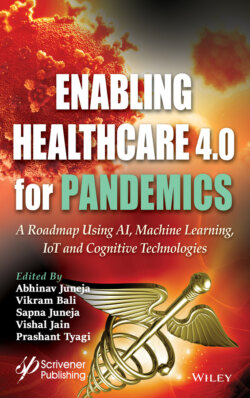Читать книгу Enabling Healthcare 4.0 for Pandemics - Группа авторов - Страница 4
List of Illustrations
Оглавление1 Chapter 1Figure 1.1 Confirmed cases in top 3 countries in the number of cases (Cumulative...Figure 1.2 Diagnosis of COVID-19 using support vector based machine learning app...Figure 1.3 Machine learning process for drug development.Figure 1.4 Machine learning approach for reuse of drug in COVID-19.
2 Chapter 3Figure 3.1 A typical linear regression graph.Figure 3.2 Multiple linear regression graph.Figure 3.3 Logistic regression graph.Figure 3.4 Decision tree graph.Figure 3.5 Workflow of the present study.Figure 3.6 States with confirmed cases of COVID-19.Figure 3.7 Comparing cases w.r.t. gender.Figure 3.8 Observed cases vs dates.Figure 3.9 Age group vs COVID-19.Figure 3.10 States with number of primary healthcare centers.Figure 3.11 State wise confirmed/cured/death cases of COVID-19.Figure 3.12 Comparison of accuracy of different models.
3 Chapter 4Figure 4.1 Machine Learning & its types.Figure 4.2 Binary classification.Figure 4.3 Multi-class classification.Figure 4.4 Steps followed in text classification process.
4 Chapter 5Figure 5.1 Illustration of Back propagation [20].Figure 5.2 Correlation between health predictive analysis and epidemic disease f...
5 Chapter 6Figure 6.1 Emerging technologies for pandemic situations.Figure 6.2 The general procedure of AI and non-AI based applications.
6 Chapter 7Figure 7.1 Total confirmed cases of top 10 worst-hit countries.Figure 7.2 The classification of Emerging Technologies.
7 Chapter 8Figure 8.1 Impact of COVID-19 on health.Figure 8.2 Global economy impact due to COVID-19.Figure 8.3 Role of digital technology during pandemic.Figure 8.4 Daily cases from 15 April to July 2020.Figure 8.5 New cases predicted for August 2020 based on training data from April...Figure 8.6 Recovery prediction for August based on the training set from April t...Figure 8.7 Death prediction for August based on the training set from April to J...
8 Chapter 9Figure 9.1 Some ingenious technologies to fight against COVID-19.Figure 9.2 Blockchain and AI for battling against COVID-19.Figure 9.3 Aarogya Setu Mobile App.
9 Chapter 10Figure 10.1 Face mask detection from group of people.Figure 10.2 Face mask detections.Figure 10.3 Smart sanitizations.Figure 10.4 COVID-19 tracking applications.Figure 10.5 Occupancy representation systems.Figure 10.6 Total sample and positive cases in Haryana.Figure 10.7 Increment rate in Haryana.Figure 10.8 Total sample and positive cases in Punjab.Figure 10.9 Increment rate in Punjab.Figure 10.10 Total sample and positive cases in Uttar Pradesh.Figure 10.11 Increment rate in Uttar Pradesh.Figure 10.12 Total sample and positive cases in Rajasthan.Figure 10.13 Increment rate in Rajasthan.Figure 10.14 Total sample and positive cases in Bihar.Figure 10.15 Increment rate in Bihar.Figure 10.16 Total sample and positive cases in Delhi.Figure 10.17 Increment rate in Delhi.Figure 10.18 Total sample and positive cases in Gujarat.Figure 10.19 Increment rate in Gujarat.Figure 10.20 Total sample and positive cases in Madhya Pradesh.Figure 10.21 Increment rate in Madhya Pradesh.Figure 10.22 Total sample and positive cases in Maharashtra.Figure 10.23 Increment rate in Maharashtra.Figure 10.24 Proposed rapid development structure.
10 Chapter 11Figure 11.1 Pseudocode of APGWO.Figure 11.2 One-point crossover operation.Figure 11.3 Two-point crossover operation.Figure 11.4 Creating a neighborhood solution.
11 Chapter 12Figure 12.1 UV disinfection robot.Figure 12.2 Telepresence robot.Figure 12.3 Disinfection robot.Figure 12.4 Surgery assisting robot.Figure 12.5 Neurosurgery assisting robot.
12 Chapter 13Figure 13.1 Impact of COVID-19 on IoT market. e: estimated; p: projected.Figure 13.2 Processes utilized by IoT for COVID-19.Figure 13.3 IoT innovations and its enthusiasm among the organizations.Figure 13.4 Healthcare framework based on IoT.Figure 13.5 Components of Smart disease surveillance.Figure 13.6 Conceptual view of Smart disease surveillance system.Figure 13.7 The conceptual diagram shown above demonstrates the integrated IoT s...Figure 13.8 Key merits of IoT.Figure 13.9 Issues in implementing IoT.
13 Chapter 14Figure 14.1 Mechanism of infection resulting from SARS-COV 2 infection [6].Figure 14.2 Source: India’s Ministry of Health and family welfare [37].Figure 14.3 Logistic growth of COVID-19 infection for Germany [40].Figure 14.4 Logistic growth of COVID-19 infection for Italy [40].Figure 14.5 Growth of Corona patients in India [41].Figure 14.6 SIR model for Japan [16].Figure 14.7 SIR model for Italy [16].Figure 14.8 Distribution of probability of last scale of the outbreak [48].
14 Chapter 15Figure 15.1 Test statistics of India till 6th May 2020 [3].Figure 15.2 Lock down analysis phase-1 [4].Figure 15.3 Regression analysis lockdown phase-1 [4].Figure 15.4 Lock down analysis phase-2 [14].Figure 15.5 Regression analysis of lockdown phase-2 [14].Figure 15.6 Lock down analysis phase-3 [15].Figure 15.7 15-day analysis of COVID-19 cases in Maharashtra [14].Figure 15.8 15-day analysis of COVID-19 cases in Delhi [15].Figure 15.9 Actual vs predicted confirmed cases for Delhi.Figure 15.10 Actual vs predicted confirmed cases for Maharashtra.
